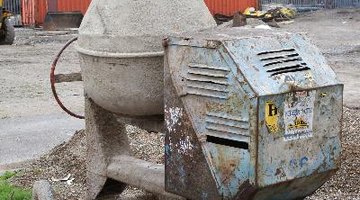How to Make Cement Molds
Cement molds create cement stones in unique sizes, shapes and textures. They may be as simple as squares, circles or other geometric shape for stepping-stones, or detailed to resemble slate or other natural rocks. The variety is limited only by the imagination of the person who makes the mold.

In addition to the variety of shapes, sizes and textures, there are many different mold-making products available, from cardboard or wood for geometric shapes, to silicone or clay for more detailed surfaces on the finished casting.
Things You Will Need
- Heavy cardboard (such as a packing box)
- Wood (fir strips or 2-by-4's)
- Packing tape
- Plywood
- Silicone caulk (squeeze tube or for caulk gun)
- Caulk gun (optional)
- Screws
- Screwdriver (or drill with screwdriver bit)
- Silicone mold putty (available online and in many craft stores)
- Plastic wrap
- Mold release agent (available at most home improvement stores)
- Spoon or kitchen knife (optional)
Tip
Pour the concrete into the mold slowly and steadily for an even finish. Tap the sides of the mold gently after filling to help air bubbles rise to the top.
Warning
Apply the spray release agent in a well-ventilated area to avoid inhalation of fumes.
Simple Geometric Shapes
-
Create the edges of the form for the mold using cardboard or wood. Choose cardboard for molds with rounded edges, irregular dimensions or simple straight-sided geometric shapes. Use wood only for straight-sided shapes such as squares, rectangles or triangles. Wood is the best choice for molds that will be reused many times.
-
Cut the cardboard into widths approximately 4 inches wide. If a more solid and reusable mold foundation is desired, instead of cardboard, use wood cut to the shape needed, provided the desired mold is a simple square, rectangle or other straight-sided shape.
-
Tape the cardboard into place in the desired shape on the plywood by placing one edge of the cardboard against the plywood to create a 4-inch deep form. Tape from the outside of the cardboard so the tape does not create indentations in the concrete when it is poured into the form. If using wood, screw the wood to the base from the underside of the base. Apply a bead of silicone caulk around the entire inside of the mold (cardboard or wood) to prevent concrete from seeping out the edges.
-
Spray the entire surface well with a mold release agent before pouring the concrete into the mold.
Detailed Surfaces
-
Create the outline of the mold as in the previous steps.
-
Soften the silicone mold putty by kneading it and then pressing it into the mold to cover its entire bottom.
-
Lay a thin sheet of plastic wrap over the silicone putty.
-
Press the desired textured object -- slate pieces, bricks or whatever you want the finished surface to resemble -- onto the plastic wrap. Remove the pieces and the plastic wrap. Use a knife, spoon or other appropriate instrument to etch additional details into the mold.
-
Allow the silicone putty to dry according to the manufacturer’s directions before spraying it with mold release agent and filling with concrete.
The Drip Cap
- Cement molds create cement stones in unique sizes, shapes and textures.
- Use wood only for straight-sided shapes such as squares, rectangles or triangles.
- Lay a thin sheet of plastic wrap over the silicone putty.
- Use a knife, spoon or other appropriate instrument to etch additional details into the mold.
- Allow the silicone putty to dry according to the manufacturer’s directions before spraying it with mold release agent and filling with concrete.
References
Writer Bio
Emily Patterson has been creating content for websites since 1996. She specializes in home improvement, natural body care and natural cleaning articles. Patterson holds a computing certificate from Penn State University.
Photo Credits
- Cement mixer image by Hedgehog from Fotolia.com
- Cement mixer image by Hedgehog from Fotolia.com
More Articles



